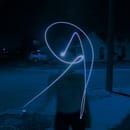It was a summer’s morning when my mother took my siblings and I to a nomadic museum in the middle of Mexico City. I remember seeing a huge sign that read “Ashes and Snow” along with a majestic picture of an elephant. Inside, I remember seeing short clips and pictures of elephants and other animals in harmony with humans. I was in total shock. Not only was I intrigued by the images, the music and the arrangement of the museum, but what I really liked was that the images did not have color. This was the first time, as a 10–year-old, that I fell in love with art and I realized that art doesn’t mean paint or color, it really means an experience and a feeling. After touring the whole museum, I begged my mother to buy me the CD that contained all the clips that we saw that day at the museum. She did. The CD is so precious to me till this day, when I watch it again, not only do I get to see Gregory Colbert’s work, but I get to relive my childhood and that same feeling I felt 11 years ago. That is why I picked Colbert, because he is my constant reminder of why I love art.
Gregory Colbert is a Canadian photographer and filmmaker. At first, Colbert used to make documentary films in the 1980s on social issues like AIDS or death. This is what eventually lead him to pursue his career in photography. His first exhibition was held in Switzerland named Timewaves, where he experimented with a new medium, print on Japanese paper. After his first exhibition, he kept doing photography but never displayed his work for more than a decade. Later, for over thirty months Colbert traveled all over the world to photograph people and animals. He was creating his most notable work, Ashes and Snow. In 2002 his pictures of elephants, whales, eagles and amongst other animals, were displayed at the Arsenale in Venice, Italy. Later on, his exhibition traveled all over the globe in the Nomadic Museum, which was visited by over 10 million people. Colbert’s photographs achieve its color, sepia and umber tones, by processing the photographs on homemade Japanese paper. It would be hard to say Colbert’s process in detail since he has kept private about the techniques and equipment he used for Ashes and Snow.
Before examining Gregory Colbert’s photographs, I would like to emphasize his description of his own work, “a celebration of all nature, an orchestra that plays not the sounds if one musician, the music of one species, but rather an expression of all of nature’s songs.” The photographs do not have any explanatory text nor set title, for Colbert wanted viewers to have an open-ended interaction with his work.
boy reading to elephant, even though I like all of Colbert’s pictures this picture is my favorite. The simple background was done to emphasize the two subjects. I also liked that the image is a wide shot because it allows the viewer to see the relative sizes between the boy and elephant. The harsh shadows and textures that we are able to see in the elephant’s skin really give the elephant dimension, almost like a personality. The boy reading to the elephant reminds me of the sense of innocence kids have and how they appreciate things adults don’t. I also think the photo highlights friendship, a friendship between the mind of two different beings. Almost all of Colbert’s pictures are of a person with one or several animals. These interactions between two different species were intended on purpose: Colbert explains it as a way to “encourage artists to explore the interaction and relationships between humans and animals and organize a series of biennial events linking art and nature.”
As I watched an interview of Gregory Colbert I understood so much about him, about who he is as a person and as an artist. The reason why he spent more than a decade traveling and learning about different cultures and commuting with animals was not to gain fame or money, but to give the world a message, specifically to newer generations. Colbert wants generations to be inspired by the “orchestra” of nature. I really believe this to be true because I see his passion and love for nature in every single clip and picture he took. He wants people to regain respect towards wildlife.
Even though he hasn’t shared his work after his breakthrough, Colbert is still making an impact. Shortly after Ashes and Snow, he founded the Animal Copyright Foundation. The meaning behind the foundation is to renegotiate our contract with nature and to give back to exploited animals. The foundation’s goal is to collect at least one percent of royalties from brands that use images of animals as advertisements. This is Colbert’s legacy: for us to see animal rights just like human rights. He wants us to celebrate our relationship with nature with love and respect. After his success, Gregory Colbert doesn’t want to be remembered as an artist, photographer or by his work, but by the love he has for nature. For his work, Colbert was named one of the ‘World’s Most Innovative People’ at the World Summit on Innovation and Entrepreneurship in 2016.


